: : : nostress ~ sidelinks : : :
welcome, to the lab of the zeroheroes !
here, in 0 time & 0 style, we'll try to serve you some interesting ressources, statements, manifests, study's, archives and other stuff that might help you to get . . . totally lost!

image (c) Bert Lezy
0

image (c) Bert Lezy
Wednesday, June 02, 2004
circology: mandalas
Zeroes and circles have always inspired human beings... The first
drawings ever made were circles! Buddhists love making mandala's,
they are mentioned as far back as in the Veda's!
an exploration of mandala's:
I had to abandon the idea of the superordinate position of the ego. ... I saw that everything, all paths I had been following, all steps I had taken, were leading back to a single point -- namely, to the mid-point. It became increasingly plain to me that the mandala is the centre. It is the exponent of all paths. It is the path to the centre, to individuation.

... I knew that in finding the mandala as an expression of the self I had attained what was for me the ultimate.
- C. G. Jung. Memories, Dreams, Reflections.
~~ C. G. Jung Links ~~ Mandala Gallery ~~ Mandala Quotes ~~ Jungian Notes~~
Theoretical Foundation for Jung’s “Mandala Symbolism”
V.Gontar
International Group for Chaos Studies at the Institutes for Applied Research, Ben-Gurion University of the Negev
P.O.Box 653, Beer-Sheva 84105, Israel
Abstract.
The mandala as psychological phenomena appear spontaneously in dreams, in certain states of conflict, and in cases of schizophrenia.

The main goal of this presentation is to give a theoretical explanation and a mathematical model for computer simulation of mandalas, based on the mechanisms of biochemical reactions in a human brain and on discrete chaotic dynamics.
The discrete dynamics of physicochemical reactions is a new theory based on the analogy between the p -Theorem of the theory of dimensionality, the principle of maximum entropy and the stoichiometry of complex chemical reactions.
Application of this theory to the spatiotemporal behavior of complex biochemical reactions has revealed symmetric patterns similar to the mandalas(link to mandals pictures) presented by C.G.Jung in his book "Mandala Symbolism". This theory has also been shown to possess the ability to generate complex oscillations, that may be used for mathematical modeling of EEG and ECG and of living systems dynamics in general.
According to the results obtained, when the human brain is generating mandalas, it can be regarded as a complex “biochemical reactor” that creates different images reflecting its internal state (or the distribution of chemicals and their biochemical interactions) and all these processes based on the laws of nature.
Mandala is Sanskrit for circle, polygon, community, connection.
The Mandala is a symbol of man or woman in the world, a support for the meditating person.
The mandala is often illustrated as a palace with four gates, facing the four corners of the Earth.

The Mandala shown here is connected with the Buddha Vajrasattva, who symbolises the original crystalline purity.
In the centre is a lotus blossom with eight petals, resting on a bed of jewels.
In the next place are the walls of the palace with gates towards the four corners of the earth.
The gates are guarded by four angry doorkeepers.
Before the meditating person arrives at the gates, she must, however, pass the four outer circles: the purifying fire of wisdom, the vajra circle, the circle with the eight tombs, the lotus circle.
 Jytte Hansen, Albertslund, Denmark
Jytte Hansen, Albertslund, Denmark
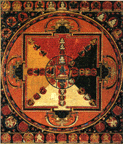
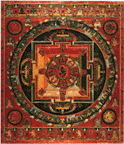
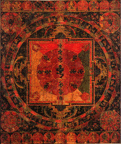
The exhibition features 14 fine Tibetan paintings of mandalas dating from the 13th to the 16th centuries,
drawn from the collections of Rossi & Rossi, London.
all images © Rossi and Rossi, London.
Exploring the Mandala
Mandalas
In Tibetan Buddhism, a mandala is an imaginary palace that is contemplated during meditation. Each object in the palace has significance, representing some aspect of wisdom or reminding the meditator of some guiding principle. Tradition dictates the shapes, sizes and colors of these objects. There are many different mandalas, each with different lessons to teach. Most mandalas contain a host of deities as well as inanimate objects.
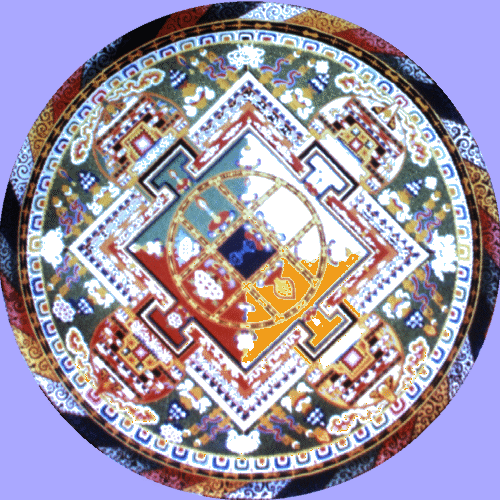
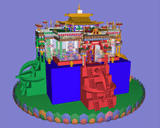
sandpaintings & computermodels

Mandalas on the Web
We search the Web for great mandala sites, so you won't have to. Our Web philosophy differs from the many "chaos is best" sentiments we have seen expressed at other sites. We believe that well ordered information is more useful to the researcher, and in no way prevents "creative wandering".
This reference is provided as a service by Clare Goodwin's Mandala Page.

We try to keep the information accurate and up to date. Alan has finally taught Clare how to check links regularly! Hopefully now there will be fewer, if any, broken links.
in te kleuren:

The Foundation for the Preservation of the Mahayana Tradition (FPMT) transmits the Mahayana Buddhist tradition and values worldwide through Tibetan Buddhist teachings, meditation, community service, Buddhist retreat centers, and projects that preserve the tradition. FPMT is based on the Gelugpa Buddhist tradition of Lama Tsong Khapa of Tibet as taught by our founder, Lama Thubten Yeshe and spiritual director, Lama Zopa Rinpoche.

::: to the top :::
::: to the lab-archives :::
::: to the :::nostress::: homepage :::
::: to the :::nostress::: archives :::
::: to the pics :::
www.flickr.com
|
0 linking 0
Blogroll Me!



